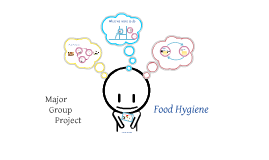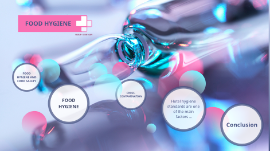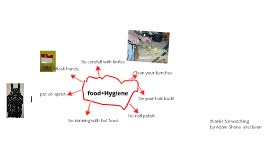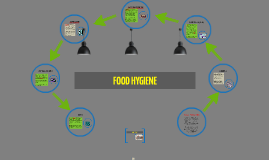food hygiene
Transcript: Food Hygiene Problems Alessandro Muñoz Tremont 6to B Food Hygiene These are the necessary conditions and measures that must be carried out when handling food in order to prevent potential damage to health, such as: Abdominal pain, Nausea, Loss of appetite Fever, Diarrhea Weakness, Fatigue Chills, Abdominal cramps, Excessive thirst Cross contamination Cross contamination It occurs when a clean food comes into contact with a surface that previously touched a contaminated food Measures to take or solutions Always separate cooked or ready-to-eat foods from those that are still raw. Wash the table and utensils before cutting vegetables (especially after cutting meat). Keep all utensils in the kitchen clean. Wash your hands very well before cooking. Everyday situations or examples When cutting the bread with a knife with which raw meat was filleted Dripping liquids from meat by thawing inside the fridge on other foods. When making pasta, use the same utensil to mix the pasta with gluten and another without gluten, without washing it previously Cold chain break Cold chain break It refers to the lack of control of the refrigeration or freezing temperature at which food must be kept from production to the final consumer, including home preservation. The use of cold in food preservation serves to slow down the growth of microorganisms responsible for poisoning or toxic infections associated with food consumption. Measures to take or solutions In frozen foods, check that the packages in the supermarket are free of frost and that their contents remain loose. Choose products that are at the bottom of the chamber or refrigerator to ensure that the food has maintained a constant temperature. Products that need refrigeration must necessarily include on their labeling the legend "keep cold" and the temperature indication. Check the temperature of your refrigerator and freezer with a thermometer. The refrigerator must maintain a temperature of 40ºF or less, and the freezer, 0ºF or less. Everyday situations or examples On many occasions people tend to defrost food at room temperature or in hot water and thus the risk of contamination is much higher (the growth of bacteria occurs mainly between 4ºC and 60ºC). When we defrost a large food, we usually take a part and freeze it again. Food, once defrosted, should not be frozen again unless cooked at more than 70ºC for at least two minutes Take food from the Mercadona freezer that exceeds the line that indicates the maximum load level of the freezer Improper cooking or overheating Improper cooking or overheating It is when the food is prepared, reheated or left at temperatures in which the microorganisms are not eliminated or their growth is favored. Food can contain pathogenic microorganisms, especially those of animal origin such as meat, fish, chicken, shellfish and eggs, for this reason they must always be cooked and very well, otherwise they can make us sick. Measures to take or solutions We must cook food in such a way that it reaches the minimum internal temperature which destroys microorganisms Whole or ground poultry (chicken, turkey and duck): 74 ° C Ground meats (beef, pork, fish): 74 ° C Injected meats: 74 ° C Pork, beef, calf and lamb: 74 ° C Fish: 74 ° C Measures to take or solutions Consume leftovers within two days. The longer cooked food is kept, the greater the risk of food poisoning. Boil both sauces and soups when reheated. If the food is very large, when cooking, cut the piece in the middle to check that it is also hot in the center. Everyday situations or examples When we cook the eggs we have to do it until the yolk and the white are firm, so it is recommended to only use recipes in which the eggs are well cooked. After preparing a meal for the family there are leftovers that will be used for reheating the next day, when reheating make sure that it is completely hot and steaming and do not reheat it more than once. If we cook a chicken, prick the thickest part of the leg and cook until the juices are minimized. The juices should not have anything pink or red. Food from unsafe sources Food from unsafe sources It is common for food to become dirty or contaminated in the various stages that go from its production to its consumption at home; in the field they can be contaminated with insecticides as well as with parasites by the black waters, during their transportation due to the conditions under which they are handled during the journey and at home when they are prepared. Measures to take or solutions 1 2 4 Solution 3 Check that the food cans are not bulging, dented or rusty, or with the security seal broken Do not consume the meat of animals that die of disease or unknown cause. Carefully clean the dry grains and seeds. Put the fruits and vegetables in chlorinated or vinegar water (5 drops per lt) for 10 min. Everyday situations or examples When preparing lettuce salad at home it is necessary to wash it by soaking it with water and vinegar since this before

















